NBA mock draft: LaMelo Ball is now a real No. 1 pick contender
There are brand-new lottery picks in our latest 2020 NBA mock draft, with LaMelo Ball moving up more than 20 spots to crash the top three.
ESPN draft analysts Jonathan Givony and Mike Schmitz have spent the summer scouting prospects across the globe, and it's time to update our projections for the upcoming draft with the latest intel.
The international crowd is already making moves. Ball and RJ Hampton both impressed at the NBL Blitz in Tasmania, and Deni Avdija notched a FIBA U20 MVP.
Here's the latest on the draft picks, with analysis from Givony on what you need to know.
2020 NBA mock draft
Pick Player Team HT POS Age
1. CLE James Wiseman Memphis 7-1 C 18.4
2. CHA Anthony Edwards Georgia 6-3 SG 18.1
3. NYK LaMelo Ball Illawarra 6-7 PG 18.0
4. MEM Cole Anthony North Carolina 6-3 PG/SG 19.3
5. PHX Deni Avdija Maccabi Tel Aviv 6-9 SG/SF 18.7
6. WAS RJ Hampton NZ Breakers 6-5 PG 18.6
7. CHI Theo Maledon ASVEL 6-5 PG 18.2
8. OKC Nico Mannion Arizona 6-3 PG 18.5
9. ATL Jaden McDaniels Washington 6-10 SF/PF 18.9
10. SAC Scottie Lewis Florida 6-5 SG/SF 19.5
11. MIN Precious Achiuwa Memphis 6-9 PF 20.0
12. DET Kahlil Whitney Kentucky 6-7 SF/PF 18.7
13. NOP Isaiah Stewart Washington 6-9 C 18.3
14. DAL Tyrese Maxey Kentucky 6-3 SG 18.8
15. ORL Tyrese Haliburton Iowa St 6-5 PG 19.5
16. SAS Matthew Hurt Duke 6-9 SF/PF 19.4
17. MIA Trendon Watford LSU 6-9 SF/PF 18.8
18. TOR Tre Jones Duke 6-3 PG 19.7
19. ATL (via BKN) Wendell Moore Duke 6-6 SF 18.0
20. MIL (via IND) Patrick Williams FSU 6-8 SF/PF 18.0
21. POR Killian Hayes Ulm 6-5 PG/SG 18.1
22. BOS Josh Green Arizona 6-6 SG 18.8
23. BKN (via GSW) Karim Mane Vanier College 6-6 SG 19.3
24. LAL Obi Toppin Dayton 6-9 PF 21.5
25. UTA Amar Sylla Oostende 6-9 PF/C 17.9
26. HOU Josiah James Tennessee 6-6 SG 19.0
27. LAC Vernon Carey Duke 6-10 C 18.5
28. OKC (via DEN) A.J. Lawson South Carolina 6-6 SG 19.1
29. BKN (via PHI) Ayo Dosunmu Illinois 6-4 PG/SG 19.6
30. BOS (via MIL) Ashton Hagans Kentucky 6-3 PG 20.2
31. CHA (via CLE) Henri Drell Pesaro 6-9 SF/PF 19.4
32. NYK (via CHA) Aaron Nesmith Vanderbilt 6-6 SF 19.9
33. PHI (via NYK) Jalen Smith Maryland 6-10 PF 19.5
34. WAS (via MEM) Kira Lewis Alabama 6-3 PG 18.4
35. MEM (via PHX) Jay Scrubb John A. Logan 6-5 SG 19.0
36. NOP (via WAS) Paul Eboua Pesaro 6-8 PF 19.6
37. CHI Isaiah Joe Arkansas 6-5 SG 20.2
38. OKC Jordan Nwora Louisville 6-8 SF/PF 21.0
39. PHI (via ATL) Devon Dotson Kansas 6-2 PG 20.1
40. SAC Reggie Perry Mississippi St. 6-9 PF/C 19.5
41. MIN Filip Petrusev Gonzaga 7-0 PF/C 19.4
42. SAC (via DEN) Malcolm Cazalon Leuven 6-6 SG/SF 18.0
43. NOP A.J. Reeves Providence 6-5 SG 20.3
44. PHI (via DAL) Arturs Zagars Joventut 6-3 PG 19.4
45. ORL Cassius Winston Michigan St. 6-1 PG 21.5
46. SAS Xavier Johnson Pittsburgh 6-3 PG 19.9
47. SAC (via MIA) Derrick Alston Boise St. 6-8 SF/PF 22.0
48. TOR Terry Armstrong SE Melbourne 6-7 SG/SF 19.1
49. BOS (via BKN) Dalibor Ilic Igokea 6-9 PF 19.5
50. IND Matthieu Gauzin Le Mans 6-4 PG 18.5
51. POR Gytis Masiulis Neptunas 6-9 PF 21.4
52. BOS Paul Reed DePaul 6-9 PF 20.2
53. DAL (via GSW) Georgios Kalaitzakis Nevezis 6-6 SG 20.6
54. ORL (via LAL) Paul Scruggs Xavier 6-3 PG/SG 21.5
55. DAL (via UTA) Jarron Cumberland Cincinnati 6-5 SG 22.0
56. SAC (via HOU) Neemias Queta Utah St. 7-0 C 20.1
57. LAC Rayshaun Hammonds Georgia 6-9 PF 21.8
58. BKN (via DEN) Mamadi Diakite Virginia 6-9 PF/C 22.6
59. PHI Borisa Simanic Red Star 7-0 PF 21.5
60. NOP (via MIL) Markus Howard Marquette 6-0 PG 20.5
LaMelo Ball's rise into the top three
It's time to start taking LaMelo Ball seriously -- possible No. 1 pick seriously -- as an NBA draft prospect.
That was the main takeaway from a four-day trip to Tasmania, home of the NBL Blitz, the Australian and New Zealand basketball league's annual preseason tournament. This year's event drew 27 NBA scouts to check on the progress of Ball and RJ Hampton, both potential top-five selections in 2020.
Ball looked like an NBL MVP candidate. He put up an impressive 19-point, 13-rebound, 7-assist performance against the defending-champion Perth Wildcats. Reigning defensive player of the year Damian Martin tried in vain to slow Ball but was completely unable to faze the 18-year-old. Ball showed similar sparks of potential in earlier preseason contests, most notably dropping 21 points on 11 shots against South East Melbourne. He has moved up to No. 3 in the new ESPN mock draft.
The feedback from NBA scouts was nearly unanimous.
"If he keeps this up, I don't see any way he isn't in the conversation for the No. 1 overall pick," one NBA executive told ESPN. "He completely changed my perception of the type of prospect he is, and all of the background info I gathered here from his coaches and teammates paint a very different story of what I thought about him off the court as well."
"He reminds me of Luka Doncic," a scout said. "Just in terms of his size, his feel and his creativity."
NBA teams also were impressed by the way Ball controlled the game, his improved shot selection and mechanics, and his body language.
"He plays with incredible pace. He's never sped up. He's never rattled by anything that's thrown at him," the same scout said. "You're expecting something magical to happen every time he has the ball. He sees everything. He can make every pass with either hand off a live dribble. His style of play is tailor-made for the NBA game, especially if you surround him with shooting and better finishers."
Many inside and outside the Australian league thought the Illawarra Hawks, typically NBL bottom-feeders, were taking a significant risk in adding Ball to their roster
via the Next Star program. There were concerns that his fame and potential intervention from Lavar, LaMelo's father, would become a distraction from winning games.
But the feedback thus far from teammates and coaches has been overwhelmingly positive, likely aided by the fact that Ball has proved to be by far the best player on the team (and possibly in the league).
"He's exceeded expectations," Illawarra head coach Matt Flinn said. "He's come with absolutely zero baggage. He's assimilated into his teammates, and they genuinely like having him around. His willingness to share the ball, his willingness to pass, that's fun to be around, and that's fun to play with. I've gotten good feedback that this is the happiest people have seen him in a while.
"I haven't heard from LaVar, so we must be doing something right [laughs]."
Ball acknowledged a need to reverse some of the negative perception NBA teams have about him, stemming from
his rocky stop in Lithuania with Prienai and the
off-the-court drama surrounding him and his family in recent years.
"I just need to be myself," he said. "People really don't know the whole background story. They get what they see on camera. Everybody who really just knows me, they already know."
NBA teams were curious how involved LaVar remains in LaMelo's basketball development process in the NBL. LaVar made a brief cameo in Illawarra upon his son's arrival, but he didn't request to come to practice, according to Illawarra staff members, and he has had minimal contact with the team.
Over the course of the weekend, Ball never donned apparel bearing the Big Baller Brand logo, sporting strictly Nike and Illawarra gear. Sources say he will be playing a minimal role in the "Ball in the Family" documentary moving forward. Meanwhile, Ball's camp has been negotiating a sneaker contract with different companies, though it remains to be seen what shoes he'll wear in the NBA.
Former NBA player Jermaine Jackson has taken over most of the responsibilities involved in managing LaMelo as his trainer and mentor. Jackson was a role player who clawed his way to a 130-game career over five seasons. He grew up in Detroit, where LaMelo's mother, Tina, is from, and coached Ball last season at Spire Academy. Jackson has been instrumental in bringing Ball back onto the NBA radar through tweaks to shooting mechanics, extensive film sessions, 5:45 a.m. beach workouts and more commitment to defense.
"Having JJ with me has been incredible," Ball said. "It's been a blessing."
While the early returns on Ball in the NBL look promising, the draft is still nine months away. Ball has a lot of work to do to solidify his standing with general managers. Most NBA teams elected to send lower-level international scouts to the Blitz. But multiple NBA teams told ESPN that they are adjusting their schedules based on scouting feedback and film to ensure they get decision-makers on a plane to scout Ball when the NBL regular season starts in October.
Ball's ability to improve his shot-making consistency, off-ball defense, finishing around the basket and decision-making -- while being a more vocal leader on the court at point guard -- will determine how high he ends up being drafted. His frame needs a lot of work too. The fact that he sat out his second game of the Blitz with a minor back injury caused some consternation among scouts.
Growing pains might be expected, though, as Ball has added over 3 inches in the past two years, and he might continue to get taller than 6-foot-7. He lacks a degree of high-end explosiveness creating offense from a standstill and beating opponents off the dribble, so maximizing his athleticism will be important. He's currently forced to rely on attempts with a high degree of difficulty inside the arc, not always able to get into the teeth of the defense and finish due to his lack of strength.
Overall, Ball appears to be in a perfect situation to showcase his abilities while making the adjustments needed to transition to the NBA game. It's early, but as far as preseason impressions go, it was difficult not to be blown away by the overall talent level he demonstrated, especially when you consider that he is one of the youngest players in this draft class, having turned 18 just a few weeks ago.
RJ Hampton's strong start
Fellow 18-year-old RJ Hampton seems to be settling into the pro game nicely. He had a solid but at times uneven start in his first NBL Blitz contest, posting 11 points, 4 assists and 3 rebounds in 21 minutes against championship-favored Melbourne United. His second game was far more impressive, as he exploded for 20 points, 5 rebounds, 3 steals, 2 blocks, 2 assists and 1 turnover on an efficient 7-of-13 shooting in 32 minutes.
NBA teams were mostly positive in their assessment of Hampton, whom, like Ball, they haven't had a chance to study as closely as other members of the 2019 high school class. Hampton elected to skip his senior year by reclassifying in May and wasn't part of the spring all-star circuit, in which most first impressions are made. Hampton's team is still behind the curve relative to its NBL counterparts, having had only two full practices and playing just its first preseason game because half the roster was competing in the FIBA World Cup with the New Zealand national team until recently.
Hampton has been handed the keys to the offense and put his impressive athleticism on full display with his ability to get virtually anywhere he wanted on the floor in Tasmania. He's an explosive athlete who changes speeds and directions fluidly with long strides, but he can also rise up on a dime for sharp pull-ups in the midrange. He made a handful of 3s, knocked down nine of 10 free throws and kept mistakes to a minimum, turning the ball over twice in 53 minutes.
His size (he has grown to nearly 6-foot-6 in shoes and might not be finished, according to the Breakers' medical staff), quickness and explosiveness will give him positional versatility once his body fills out. He covers an incredible amount of ground defensively, which he showed with a series of exhilarating blocks and steals in the second contest.
Hampton still has several areas in which scouts want to see him improve. He's transitioning to being a full-time point guard, having some difficulties getting his team into their offense against ball pressure and looking a little shaky with his decision-making at times. He showed poor awareness navigating screens off the ball defensively, was beaten off the dribble and lacks strength in a major way, as he was pushed around by older players.
However, the Breakers' coaching staff and teammates insist that Hampton is well ahead of schedule. They rave about how coachable he is and his level of professionalism, and Hampton expressed satisfaction thus far as well.
"RJ is great," Breakers head coach Dan Shamir said. "I thought it was going to be a process, but he is ready for this level, and I am very satisfied with him so far."
Unlike Ball, Hampton is on a far more talented roster, which means he probably won't put up eye-popping numbers, though he'll likely win more games.
"If RJ was on Illawarra, he would score 30 points every game," veteran American guard Sek Henry told ESPN. "On our team, that's not his role. We need him to do other things. You should see what he does in practice, though. His talent is through the roof."
Scouts in Tasmania think Hampton has a higher floor than Ball, as well as a significant ceiling in his own right. They want to see how much improvement he makes defensively and with his playmaking ability as the season moves on, plus what kind of consistency he can find as a shooter. Hampton has passed Theo Maledon in our mock draft, but Ball's ascension into the top three and Avdija's outstanding form this summer keep Hampton steady at No. 6 in our latest projections.
He'll have an opportunity to continue to help himself with the two NBA preseason games the Breakers will play Oct. 8 and 10 in Memphis and Oklahoma City.[/QUOTE]



